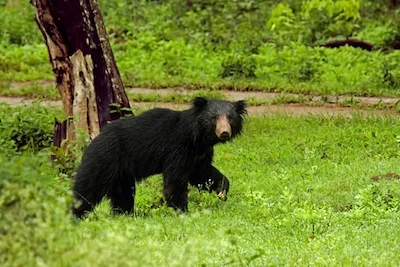Sloth bears have shaggy black fur that looks messy.
Their favourite food is termites and ants.
They use their lips like a straw to suck them up.
Sloth bears live in forests in hot places.
Sometimes they hang upside down in trees.
General facts about all bears
©Getty Images
Bears are mammals.
Bears are found in many habitats in different countries.
Bears all have a large body with strong legs and a short tail. They have a snout rather like a dog's snout. They have thick fur. Their paws have five claws that do not pull back like a cat's claws do.
Bears generally live alone, except when a mother is raising cubs.
There are eight different kinds of bear.
See a map of where the different kinds of bear are found
The word ‘sloth’ means laziness, extreme sloppiness. A sloth bear looks very shaggy and untidy, as though it was too lazy to comb its hair. It looks a bit like another animal called a sloth. However, they are not related to sloths, and they are not slow moving. They are agile bears that can run faster than a human. At first, scientists thought it was part of the sloth family, then discovered that it was part of the bear family. Sloth bears sometimes hang upside down from tree branches and young ones ride on their mother's back, very like sloths do. However, the sloth bear is not slow moving like the sloth, which hardly moves all day.
What does a sloth bear look like?
©Getty Images
Sloth bears have long, shaggy black fur on their heads and backs, with a large white or yellow Y-shaped patch of hair on their chests. The hair around the neck and back of the head is longer, like a mane. They are the only bear to have long hair on their ears. The fur on their undersides is much shorter. Their tails are long for a bear, about 15 cm long. They have no front teeth, and they suck termites out of their nests through this gap. They close their nostrils when raiding termite mounds so they don’t inhale the insects, and use their lips like the nozzle of a vacuum cleaner. They have a long muzzle with loose lips that can move easily. Their 7 cm long, curved claws are used for breaking up the hard termite nests.
They grow up to about one and a half metres in length. Adult males can weigh around140 kilograms, and adult females can weigh around 95 kilograms.
What is the distribution and habitat of sloth bears? (where they are found)
Sloth bears are found in Southeast Asia, in Sri Lanka, India, Bangladesh, Nepal, and Myanmar (Burma). They live in a variety of warm, humid forests or in grasslands near the equator. They can live in different kinds of forest - dry thorn forests or wet tropical forests.
What are its behaviours?
©Getty Images
Sloth bears are mainly nocturnal, which means they are most active at night and sleep most of the day. When threatened, they stand on their hind legs and show the claws of their front paws. They are excellent tree climbers, and are often seen hanging upside down from a tree branch. Because they live in places that do not have cool winters, sloth bears do not hibernate, but in the tropical rainy season they sometimes stay in caves, and wait out the rains in a rather sleepy state.
What do sloth bears eat?
Sloth bears are omnivorous, eating both plants and meat. However, their diet is mostly termites and ants that they suck out of their nests, making very loud snuffling noises as they do so. They also eat fruit and flowers, including figs and mango. They knock beehives out of trees and eat the honey and bee larvae. They sometimes raid farms and feed on crops such as sugarcane, corn and yams. They eat carrion, which is any dead animals they might find, and they also eat anything left over from the meal of an animal such as a tiger.
What is the sloth bear's life cycle?
A sloth bear cub. ©Getty Images
There is not a set time or season of the year when sloth bears mate. About seven months after mating with a male, a female gives birth to cubs, usually two. They are born in a nest the mother makes in a cave or under rocks. Cubs are blind and helpless at birth, but after a month come out of the den and ride on their mother's back as she travels about the forest, which no other bears do. The cubs stay with their mother for about 2-3 years, or until they are about 22 kilograms in weight, when they begin to live on their own.
Conservation status and threats
©Getty Images
The sloth bear has been classified as Vulnerable. This means they are likely to become endangered if action is not taken to conserve them. Their habitat is rapidly disappearing as it is cut down to make way for human homes and farms.
Luckily, in India, conservation efforts to save the Bengal tiger have helped conserve sloth bears and other animals that share the same habitat. It is estimated that there are between 1000 and 7000 sloth bears in the wild.






